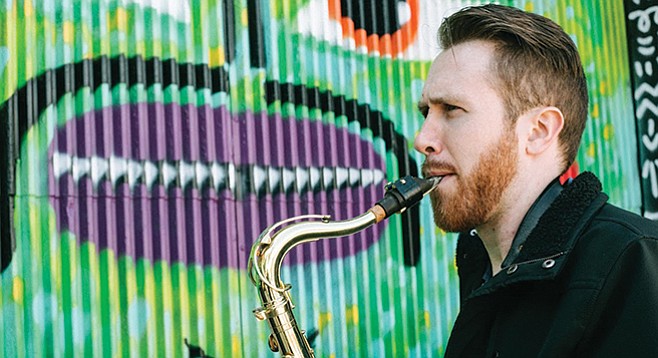 Facebook
Facebook
 X
X
 Instagram
Instagram
 TikTok
TikTok
 Youtube
Youtube

“There are more people playing jazz music at a higher level than ever before in the history of jazz.” That’s Ian Buss’s answer when I ask him about choosing a career playing straight-ahead jazz music for an audience that, according to industry sales figures, is disappearing. “But yes, I’d say more people are playing jazz than making a living at it.” Anymore, the gig as he describes it is something like fighting the good fight just to keep the music alive.
Buss is 26. He plays saxophone and he composes. “I moved here last February from New York. I originally grew up in San Diego.” Buss left for New York to study at the New School for Jazz & Contemporary Music. “After I graduated, I stayed and played there for years.” Buss has a big tone, as if his tenor sax is powered by something other than breath. “I love warm, dark saxophone sounds.” The intimate and almost conversational feel of his style comes from a mix of skills and substance gained early in the game.
“You have to consider how what you play sounds to people who aren’t jazz musicians. It comes down to the story, what the song is about.” But jazz is not his generation’s music. What convinced him to go that route? Cannonball Adderley, he explains. “I’d put on Miles Davis’ Kind of Blue while I was doing homework for background music, and Cannonball’s sax solos stuck out. He just really made the horn sing.”
For Dizzy’s, Buss handpicked four locals to back him: pianist Danny Green, Matt DiBiase on vibes, bassist Mackenzie Leighton, and percussionist Julien Cantelm. Buss says the show is mapped around favorite songs borrowed from the American Songbook with additional material from composer Leonard Bernstein and the Beatles. “I’ll be playing some of my original music as well,” he says. His formula? “It’s about writing music that speaks to people in a certain way.”


“There are more people playing jazz music at a higher level than ever before in the history of jazz.” That’s Ian Buss’s answer when I ask him about choosing a career playing straight-ahead jazz music for an audience that, according to industry sales figures, is disappearing. “But yes, I’d say more people are playing jazz than making a living at it.” Anymore, the gig as he describes it is something like fighting the good fight just to keep the music alive.
Buss is 26. He plays saxophone and he composes. “I moved here last February from New York. I originally grew up in San Diego.” Buss left for New York to study at the New School for Jazz & Contemporary Music. “After I graduated, I stayed and played there for years.” Buss has a big tone, as if his tenor sax is powered by something other than breath. “I love warm, dark saxophone sounds.” The intimate and almost conversational feel of his style comes from a mix of skills and substance gained early in the game.
“You have to consider how what you play sounds to people who aren’t jazz musicians. It comes down to the story, what the song is about.” But jazz is not his generation’s music. What convinced him to go that route? Cannonball Adderley, he explains. “I’d put on Miles Davis’ Kind of Blue while I was doing homework for background music, and Cannonball’s sax solos stuck out. He just really made the horn sing.”
For Dizzy’s, Buss handpicked four locals to back him: pianist Danny Green, Matt DiBiase on vibes, bassist Mackenzie Leighton, and percussionist Julien Cantelm. Buss says the show is mapped around favorite songs borrowed from the American Songbook with additional material from composer Leonard Bernstein and the Beatles. “I’ll be playing some of my original music as well,” he says. His formula? “It’s about writing music that speaks to people in a certain way.”
Comments